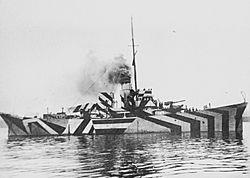HMS Kilbride facts for kids

HMS Kilbride, pictured in 1918 with dazzle camouflage
|
|
Quick facts for kids General characteristics |
|
|---|---|
| Type | Sloop |
| Displacement | 895 tons |
| Length | 182 ft (55 m) |
| Beam | 30 ft (9.1 m) |
| Draught | 10 ft 6 in (3.20 m) |
| Installed power | 1,400 ihp (1,000 kW) |
| Propulsion |
|
| Speed | 13 knots |
| Complement | 57 |
| Armament |
|
The HMS Kilbride was a special type of ship called a sloop. It was built for the Royal Navy during World War I. This ship belonged to the Kil class, which were also known as gunboats.
These ships were designed to hunt and fight enemy submarines. However, the Kilbride was finished too late in the war to see much action. The Kil-class ships had a clever design: both ends looked the same. This was meant to confuse enemy submarines about which way the ship was heading. They also wore "dazzle camouflage", which was a wild paint job to make them harder to target.
Kilbride started its service near the end of World War I. It was later sold for regular commercial use in 1920. After that, it was sold to owners in Italy. Sadly, the ship was sunk by British aircraft in January 1943 during World War II.
Contents
Building the Kilbride and Its Design
The Kil class of ships was planned to be patrol and escort vessels. They were meant to be better than the fishing trawlers the navy was using. These new ships could handle rougher seas, travel farther, and move faster.
Large orders for these new "fast trawlers" began in July 1917. The navy eventually ordered 85 of them! In January 1918, these ships were officially called patrol gunboats.
The ships were about 182 feet (55 m) long from end to end. They were 30 feet (9.1 m) wide and had a draught (how deep they sat in the water) of about 10 feet 6 inches (3.20 m). They weighed around 895 long tons (909 t).
A cool feature was their symmetrical, double-ended hull. This meant the front and back looked exactly alike. It was a trick to make it harder for enemy submarines to guess the ship's direction.
Power and Weapons
These ships were powered by a single triple-expansion steam engine. This engine got its steam from a cylindrical boiler that burned coal. The engine could produce 1,400 indicated horsepower (1,000 kW) of power. This allowed the ships to reach a speed of 13 knots (15 mph; 24 km/h).
Each ship was designed to carry one 4-inch gun. They also carried at least six depth charges. Depth charges were special bombs dropped into the water to destroy submarines. The crew for these ships was 39 officers and other sailors.
The Kilbride itself was built at Hall Russell's shipyard in Aberdeen. It was launched into the water on August 21, 1918.
A Mutiny on Board
On January 13, 1919, something unusual happened on the Kilbride. There was a mutiny while the ship was docked at Milford Haven. A mutiny is when a group of sailors or soldiers refuse to obey orders from their commanders.
Eight men from the ship were put on trial. They were charged with taking part in a non-violent mutiny. They were given sentences of 90 days to two years of hard labor. After their sentences, they were dismissed from the navy.
The Kilbride was sold on February 14, 1920. It was bought by a company called Robinson, Brown & Joplin. They planned to change it for civilian use and then sell it again. The ship was renamed Scotsgap at this time.
Later, it was renamed Rebus, and then Poggioreale. By 1930, the ship was registered in Genoa, Italy, and called Nino di Gailura. In 1933, it was renamed Alfredo. By then, it had a new oil engine instead of its old steam engine.
Sadly, the Alfredo was sunk by British aircraft on January 20, 1943. It was still listed in the Lloyd's Register (a record of ships) at the start of 1943. However, it was later marked as a "War Loss" that same year.

